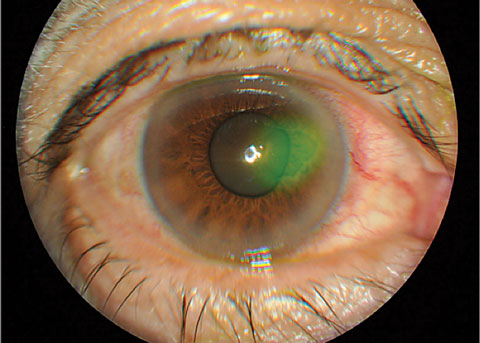 |
|
A recent study from the Cleveland Clinic and published in the journal Cornea reveals that higher doses of topical losartan, used for corneal injuries, may lead to increased ocular toxicity and discomfort. Researchers found that while traditional dosing of 0.8mg/mL is effective and safe, higher concentrations (8mg/mL and 40 mg/mL) resulted in severe side effects. They also suggested an even lower dose of the medication—0.2mg/mL six times a day—for corneas with epithelial defects. Photo: Tarah N. Lee, OD. Click image to enlarge. |
Topical losartan, commonly used for the treatment of corneal injuries, has traditionally been administered in doses of 0.8mg/mL six times per day. However, reports circulated of a patient who was treated with topical losartan 8mg/mL six times per day for several weeks due a compounding pharmacy error, without experiencing discomfort or other detrimental effects. The patient was returned to the standard dose, but the speculation among cornea specialists had already begun, as they discussed whether the therapy would be more effective at higher concentrations. This incident spurred new research from the Cleveland Clinic’s Cole Eye Institute, published in the journal Cornea, comparing the efficacy of different doses of topical losartan in rabbit eyes. The study suggests higher doses of the medication don’t improve efficacy and instead cause severe discomfort, increased ocular surface toxicity and in some cases persistent epithelial defects.
This study included 18 rabbit eyes experiencing standardized alkali burns. Six eyes per group were treated with topical losartan in doses of 0.8mg/mL, 8mg/mL or 40mg/mL, each six times daily. In the group receiving 40mg/mL, researchers noted severe discomfort and ocular surface toxicity in all subjects and discontinued treatment at nine days. Those receiving the 8mg/mL dose had less discomfort on application, but there were persistent epithelial defects and marked stromal opacity in five of the six eyes after one month of treatment. Topical losartan 0.8mg/mL was well-tolerated by rabbits and corneal opacity was markedly reduced at one month in five of the six corneas.
The authors also extrapolated that, since stromal and epithelial toxicity increase as the dosage of topical losartan increases, the dose should be lowered to 0.2mg/mL six times per day in corneas with an epithelial defect, which could then be increased to the standard 0.8mg/mL one it heals.
These results culminated in the authors writing that they “do not recommend using dosages of topical losartan greater than 0.8mg/mL to treat corneal scarring fibrosis.”
They continued, “It should be emphasized, however, that 0.8mg/mL losartan six times per day has been safe and effective in hundreds of patients treated throughout the world thus far with this dosage and frequency when the epithelium was intact.” As a result, they suggest treating corneas with an epithelial defect with 0.2mg/mL losartan six times per day until the epithelium is fully closed and then transition to the higher dose of 0.8mg/mL on the same regimen. But corneas with stromal scarring and an intact epithelium can usually be safely treated with 0.8mg/mL losartan six times per day, they explained in their paper.
A potential limitation noted by the researchers was the use of losartan during the active phase of scar formation after the alkali-burn injury. The response to losartan could be different in established scars, they said, although there are reports to support that existing scars do respond well to losartan. “It is likely that scars present for many years or decades will respond to topical losartan treatment, although clinical trials are needed to verify this hypothesis,” according to the authors.
Topical losartan is only available from compounding pharmacies and used off-label, which creates a burden for physicians to identify a pharmacy that is licensed to ship to their state. “At present, patients in some states are unable to obtain topical losartan due to state laws governing compounding pharmacies,” wrote the authors. “Hopefully, with time, clinical trials to obtain approval will alleviate these discrepancies in drug availability.”
In summary, the researchers presented their suggested treatment guidelines in which 0.2mg/mL losartan six times per day is used when an epithelial defect is present and 0.8mg/mL losartan six times per day is used when the corneal epithelium is intact. These findings suggest higher concentrations of topical losartan produce increasing epithelial toxicity and alterations in the myofibroblast response to the treatment.
| Click here for journal source. |
Dutra BAL, Martinez VV, Santhiago MR, Wilson SE. Topical losartan dosage response and corneal toxicity at higher concentrations. Cornea. October 23, 2024. [Epub ahead of print.] |

